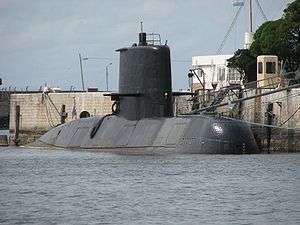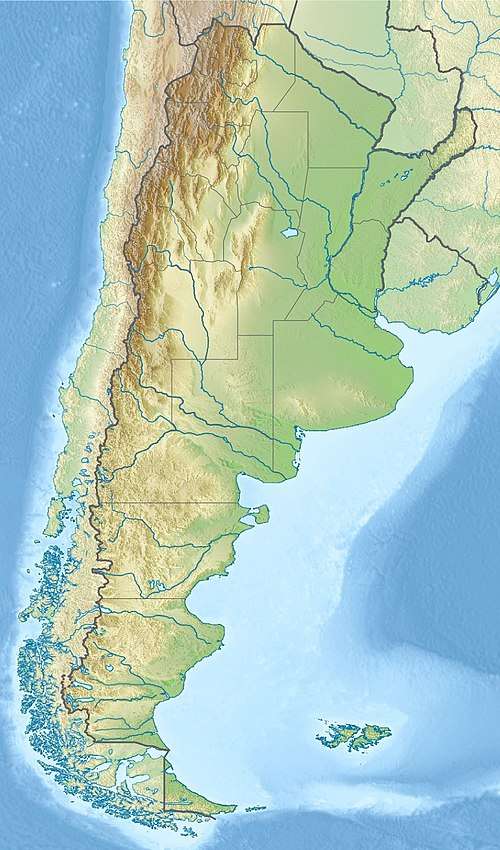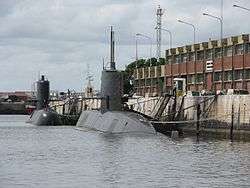ARA San Juan (S-42)
 ARA San Juan (S-42) in 2007 | |
| History | |
|---|---|
| Name: | San Juan |
| Namesake: | San Juan Province, Argentina |
| Builder: | Thyssen Nordseewerke, Emden, West Germany |
| Completed: | 28 June 1983 |
| Commissioned: | 19 November 1985 |
| Out of service: | 15 November 2017 |
| Refit: | 2014 |
| Struck: | 2017 |
| Homeport: | Mar del Plata |
| Fate: | Lost with all 44 hands on board, in the Atlantic Ocean[1] |
| Status: | Lost |
| General characteristics | |
| Class and type: | TR-1700-class submarine |
| Displacement: |
|
| Length: | 67.30 m (220.8 ft) |
| Beam: | 8.36 m (27.4 ft) |
| Draught: | 7.34 m (24.1 ft) |
| Propulsion: |
|
| Speed: |
|
| Range: | 12,000 nmi (22,000 km) at 8 kn (15 km/h) surfaced |
| Endurance: | 30 days |
| Complement: | 37 |
| Sensors and processing systems: |
|
| Armament: |
|
ARA San Juan (S-42) was a TR-1700-class diesel-electric submarine in service with the Argentine Navy as part of the Argentine Submarine Force between 1986 and 2017. The submarine was built in West Germany and entered service on 19 November 1985. San Juan underwent a mid-life update from 2008 to 2013.
On 15 November 2017, San Juan stopped communicating during a routine patrol in the South Atlantic off the coast of Argentina. A multi-nation search operation was mounted to try to locate the submarine, which was believed to have suffered an electrical malfunction. Within hours of San Juan's last transmission, reports describe an acoustic anomaly consistent with an explosion, detected in the vicinity of the vessel's last known location. On 30 November, hopes of rescuing the crew alive were abandoned.
Design
Built by Thyssen Nordseewerke,[2][3] San Juan was laid down on 18 March 1982 and launched on 20 June 1983. It had a single-hull design, with a lightweight bow and stern and a watertight superstructure in the central part. Her sister vessel, ARA Santa Cruz, is the only other one of her type, though the program originally sought to produce a larger number of submarines.[4]
Name
The submarine's name derives from the province of San Juan; the names of all Argentine submarines begin with the letter S. Past ships with the same name are a destroyer (1911), a surveyor (1929), and a torpedo boat (1937).[5]
The prefix ARA is the acronym of the Argentine Navy in Spanish (Armada de la República Argentina).[6][7]
Operational history
The submarine entered service on 18 November 1985.[8]
In 1994, during the FleetEx 2/94 "George Washington" exercise with the United States Navy, San Juan managed to avoid detection by US antisubmarine forces for the entire duration of the war game, penetrating the destroyer defense and "sinking" the command ship USS Mount Whitney.[9][10] The submarine has taken part in other exercises including Gringo-Gaucho and UNITAS.[8]
A mid-life update was carried out in Argentina between 2008 and 2013, taking longer than expected due to budget constraints.[11][12] The upgrade cost around 100 million pesos ($12.4 million) and comprised more than 500,000 work hours during which the submarine was cut in half and had her four MTU engines and batteries replaced.[13] The updates were carried out at the Argentine Industrial Naval Complex's (CINAR) Tandanor and Storni shipyards.[4] Later, San Juan was tasked with carrying out surveillance exercises in the economic zone around Puerto Madryn, particularly in the role of combating illegal fishing.[14][15]
Disappearance and rescue efforts

On 17 November 2017, it was announced that San Juan had not been heard from since 15 November when the vessel was on its way to Mar del Plata from Ushuaia following a military exercise, and that a search and rescue operation had been launched 200 nautical miles (370 km; 230 mi) southeast of San Jorge Gulf.[17][18] [19][20] There were 44 servicemen on board the missing submarine,[21] including Argentina's first female submarine officer, Eliana María Krawczyk.[22] The submarine carried oxygen for no more than seven days when submerged.[23][22]
The search and rescue operation was carried out under the auspices of ISMERLO, an international organisation of over 40 countries set up in 2003[24] following the Kursk submarine disaster.[25] The search area was 482,507 square kilometres (186,297 sq mi) in size[26] and weather conditions throughout the search and rescue period changed, making the task far more difficult on days with large waves and high winds.[27][28]
On 23 November the Argentine Navy said an event consistent with an explosion had been detected[29] on the day the submarine lost communications by CTBTO seismic anomaly listening posts on Ascension Island and Crozet Islands.[30][29][31][29][32]
By 24 November, the search and rescue operation involved more than 30 aircraft and ships from Argentina, the United Kingdom, Brazil, the United States, Chile and other countries. In all, more than 4,000 personnel from 13 countries assisted the search, scouring an area the size of Spain.[33]
On 27 November, it was revealed to the press that according to the submarine's last report from 15 November, San Juan's snorkel had leaked water into the forward storage batteries the day before, which ignited a fire. After quenching the fire, the crew disconnected the forward storage batteries. The submarine continued to move powered by the aft batteries.[34]
On 30 November, 15 days after San Juan went missing, the Navy declared the rescue part of the operation to be over, turning its attention to finding the submarine and not her crew.[1] The loss of 44 crewmen constitutes the largest loss of life aboard a submarine since the Chinese submarine 361 sank on May 2003.[35]
Gallery
 Submarines San Juan and Santa Cruz, Mar del Plata naval base, 2007
Submarines San Juan and Santa Cruz, Mar del Plata naval base, 2007.jpg) Submarine San Juan, Buenos Aires naval dock, May 2017
Submarine San Juan, Buenos Aires naval dock, May 2017
See also
Footnotes
References
- 1 2 "Submarino ARA San Juan: la Armada dio por finalizado el operativo de rescate y ya no busca sobrevivientes". La Nacion (in Spanish). 30 November 2017. Retrieved 30 November 2017.
- ↑ Latinoamericana, Comunidad Submarinista. "Reparación de Media Vida Submarino Tipo TR1700 ARA San Juan S-42 (Segunda Parte)". Retrieved 17 November 2017.
- ↑ Miller, David (2002). The Illustrated Directory of Submarines. Zenith Press. p. 480. ISBN 0-7603-1345-8.
- 1 2 Castro, Pablo (5 March 2009). "Reparación de Media Vida Submarino Tipo TR1700 ARA San Juan S-42 (Primera Parte)". www.elSnorkel.com (in Spanish). Retrieved 18 November 2017.
- ↑ "Por qué se llama San Juan el submarino que es intensamente buscado". Diario de Cuyo. 17 November 2017. Retrieved 19 November 2017.
- ↑ F. A. Buttress; H. J. Heaney (6 December 2012). World Guide to Abbreviations of Organizations. Springer Science & Business Media. p. 104. ISBN 978-1-4684-8742-8.
- ↑ A. Donaghy (2 September 2014). The British Government and the Falkland Islands, 1974-79. Palgrave Macmillan UK. p. 10. ISBN 978-1-137-32956-1.
- 1 2 Latinoamericana, Comunidad Submarinista. "Submarino Argentino ARA San Juan vuelve a estar en el agua". www.elSnorkel.com (in Spanish) (2 July 2014). Retrieved 22 November 2017.
- ↑ "El día que el ARA San Juan sorprendió a la Armada de Estados Unidos". La Nacion. 22 November 2017. Retrieved 22 November 2017.
- ↑ Latinoamericana, Comunidad Submarinista (8 December 2014). "Ejercicio Fleetex 2/94 "George Washington"". www.elSnorkel.com (in Spanish). Retrieved 22 November 2017.
- ↑ Kiernan, Sergio (3 August 2014). "El arte de reparar submarinos". Pagina 12 (in Spanish). Retrieved 18 November 2017.
- ↑ Piñeiro, Luis (20 September 2016). "Comienza en Argentina la modernización del submarino TR-1700 ARA Santa Cruz-noticia defensa.com". Defensa.com. Retrieved 18 November 2017.
- ↑ "Argentine Navy receives refurbished TR1700 class submarine ARA San Juan". MercoPress. 19 June 2014. Retrieved 17 November 2017.
- ↑ "How Did Argentina Lose a Submarine And Its Crew?". Telesur. 17 November 2017. Retrieved 17 November 2017.
- ↑ Morales, Fernando (17 November 2017). "Cómo es el submarino ARA San Juan que es intensamente buscado". Infobae (in Spanish). Retrieved 18 November 2017.
- ↑ "Missing sub 'reported breakdown'". 21 November 2017. Retrieved 23 November 2017 – via www.bbc.com.
- ↑ "Argentine navy loses contact with submarine". BBC. Retrieved 17 November 2017.
- ↑ "Operaciones integradas del Comando de Adiestramiento y Alistamiento | Gaceta Marinera". gacetamarinera.com.ar (in Spanish). 6 November 2017. Retrieved 21 November 2017.
- ↑ "La Flota de Mar despliega su esplendor en Ushuaia". Zona Militar (in Spanish). 7 November 2017. Retrieved 21 November 2017.
- ↑ "Desapareció un submarino argentino y se desplegó un operativo de rescate" (in Spanish). La Nacion. 16 November 2017. Retrieved 18 November 2017.
- ↑ Melgar, Ana; Gallón, Natalie & Hanna, Jason. "Argentine navy says its lost contact with submarine". CNN. Retrieved 17 November 2017.
- 1 2 Politi, Daniel & Londoño, Ernesto (17 November 2017). "Search Underway for Argentine Navy Submarine With 44". New York Times. Retrieved 17 November 2017.
- ↑ Uki Goñi (20 November 2017). "Missing Argentinian submarine running out of air as search enters 'critical phase'". The Guardian. Retrieved 20 November 2017.
- ↑ "An officer of Italian Navy at the head of ISMERLO". Marina Militare. 17 July 2015. Retrieved 22 November 2017.
- ↑ "Qué es Ismerlo, el sistema internacional que alertó al mundo sobre el ARA San Juan". La Nacion. 21 November 2017. Retrieved 21 November 2017.
- ↑ "Submarino ARA San Juan: qué se sabe hasta ahora sobre su desaparición y la búsqueda para encontrarlo". La Nacion. 21 November 2017. Retrieved 21 November 2017.
- ↑ "Con las mejoras meteorológicas, se intensifica la búsqueda del submarino". Telam. 21 November 2017. Retrieved 21 November 2017.
- ↑ "El fuerte viento demora el operativo y complica las tareas de rescate". La Nacion (in Spanish). 26 November 2017. Retrieved 26 November 2017.
- 1 2 3 "'Explosion' dashes sub crew survival hopes". 23 November 2017. Retrieved 23 November 2017 – via www.bbc.co.uk.
- ↑ "Submarino ARA San Juan: cómo se detectó la explosión y qué podría significar". La Nacion. 23 November 2017. Retrieved 23 November 2017.
- ↑ "Vocero de la Armada: "Hubo un evento singular consistente con una explosión" en el ARA San Juan". Telam. 23 November 2017. Retrieved 23 November 2017.
- ↑ "Búsqueda del ARA San Juan: cómo se detectó la explosión y por qué se conoció una semana después". Infobae (in Spanish). 23 November 2017. Retrieved 23 November 2017.
- ↑ "U.S. Navy plane scours South Atlantic in search for Argentine sub". 24 November 2017. Retrieved 14 December 2017 – via Reuters.
- ↑ Clarin.com. "Submarino ARA San Juan: cómo fue el principio de incendio en las baterías" (in Spanish). Retrieved 2017-11-28.
- ↑ Politi, Daniel; Londoño, Ernesto (30 November 2017). "Hope for Argentina Submarine Crew Fades". The New York Times. Retrieved 13 July 2018.
Further reading
- Amendolara Bourdette, Ignacio (2005). Guia de los buques de la Armada Argentina 2005–2006 (in Spanish and English). Buenos Aires, Argentina. ISBN 987-43-9400-5.
- Burzaco, Ricardo (1999). SUBMARINOS DE LA ARMADA ARGENTINA 1933 - 2000 (in Spanish). Buenos Aires, Argentina: Eugenio B. ISBN 9789879676417.
External links
| Wikimedia Commons has media related to ARA San Juan (S-42). |
- Latin-American Submariners Community website (in Spanish)
- Argentine Submarine Force official website – Archived page (in Spanish)
- (in Spanish) Argentine Navy official website – Submarine Force page (Poder Naval – Fuerza de Submarinos – Unidades (accessed 2017-02-04)
- Submarine Shipyard Nordseewerke official site (in German)
- CN (RS) Carlos A Zavalla. "LA ENTREGA DEL SUBMARINO SAN JUAN" (in Spanish). Fundacion Histarmar. Retrieved 9 December 2017.
- Carlos Mey. "TR-1700, Imagenes del Interior" [ARA San Juan, interior pictures] (in Spanish). Fundacion Histarmar. Retrieved 10 December 2017.
